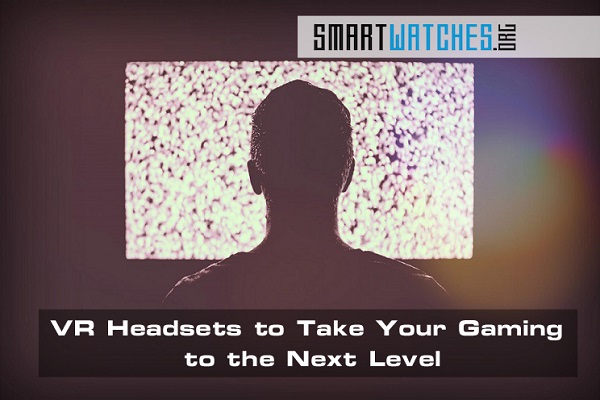Virtual reality is back with a bang! Many brands are launching virtual reality headsets for media and entertainment purposes. Some of the biggest names in the business include Oculus, HTC, Avegant, Sony (Playstation), Microsoft, and more.
This year will surely be the one that virtual reality headsets go mainstream.
If – for some odd reason – you’ve never heard of virtual reality before, don’t worry your pretty little head. We’re going to explain it in as much detail as possible.
What is Virtual Reality?
Virtual reality is a digital space that you can immerse yourself in, and this is achieved through advanced technology. The most common form of experiencing virtual reality is by wearing a headset that tracks your head movements and translates that data as a form of control, which is then played back in a virtual world. For instance, with the Oculus Rift you enter the world of a game by putting on the headset, and when you look left or right, your character in the game world does the same thing.
Ideally, virtual reality is a way to bridge the gap between our reality and a digital one. There are a ton of science-fiction movies and books that explore the idea of superior VR tech some of which allows people to submit their entire bodies into a digital space. The technology we have today is nowhere near as advanced. Generally, it involves putting on one of many virtual reality headsets, while using a combination of movement, gesture and physical controls.
Virtual reality tech did appear back in the 90s, but it just never became popular enough to meet success. Part of this is likely because we didn’t have the technology and hardware back then to make it so.
With today’s virtual reality headsets, however, developers have been able to create some amazing and revolutionary experiences. Sony is currently working on a headset called Playstation VR for their Playstation console. When it launches, players will be able to step inside digital game worlds using a headset that is connected to their PS4. They’ll be able to explore fictional worlds, without ever leaving their living room.
If you don’t find that interesting or amazing, then you’re definitely in the wrong place.
What is Augmented Reality?
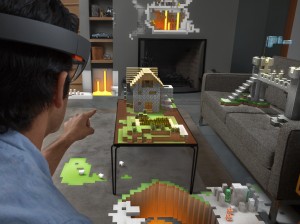 Another form of virtual reality tech is called augmented reality – or AR. The biggest difference between the two is that augmented reality actually uses a form of visual hardware to place digital information and media into the real world. That said, these digital projections are only ever visible to those wearing the AR gear.
Another form of virtual reality tech is called augmented reality – or AR. The biggest difference between the two is that augmented reality actually uses a form of visual hardware to place digital information and media into the real world. That said, these digital projections are only ever visible to those wearing the AR gear.
One of the most popular forms of AR came from an Android game called Ingress. By using their phones, players can see game nodes and elements in the real world. Thus, they are actually walking around the real world, traversing the physical plain, while looking at digital content projected into it.
Google Glass, was another form of AR tech. Wearers didn’t actually enter a digital world, instead, it was a pair of glasses that output digital content and displayed it in front of their eyes over real world elements.
Microsoft is working on a headset like this called HoloLens. It will allow users to interact with digital object in a physical environment.
Imagine a vehicle that displays GPS routes, potential destinations, and hotspots on your windshield. That digital information being projected is a form of augmented reality. Because the information is actually being displayed in the real world, instead of a digital one, it is considered augmented.
AR tech can come in many forms, the most common of which are smartphone apps, headsets or glasses, portable game consoles, toys and more.
Virtual Reality is the True Innovation
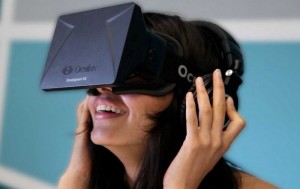 Augmented reality is just as amazing, and there are many benefits that can come from using this technology. However, virtual reality is the truly innovative form of the two. This is because developers and content creators must deliver a realistic experience through many dimensions. Once you place one of these virtual reality headsets on your person, in order for the experience to be believable, you need to be fully immersed through all of your senses. VR tech will need to deliver realistic sound, visuals, movement, and much more.
Augmented reality is just as amazing, and there are many benefits that can come from using this technology. However, virtual reality is the truly innovative form of the two. This is because developers and content creators must deliver a realistic experience through many dimensions. Once you place one of these virtual reality headsets on your person, in order for the experience to be believable, you need to be fully immersed through all of your senses. VR tech will need to deliver realistic sound, visuals, movement, and much more.
With virtual reality tech, you are entering digital worlds completely.
Sadly, the market has become so innovative that nearly every electronics company out there is creating VR tech. If you’re new to this whole VR scene, you’re going to have a bit of trouble deciding which platforms to hedge your bets on. So, we’re going to take a brief look at all the different VR tech that’s out there, in hopes that you might find the platform that suits your needs best.
Keep in mind, most of the virtual reality headsets below are for gaming purposes, but a few of them will offer general entertainment support, as well.
The Top Virtual Reality Headsets
There are a ton of virtual reality headsets making the rounds lately. Some are just prototypes or concepts while others are retail products you can own. We’re going to take a look at the most popular ones.
Oculus Rift
The Rift is a virtual reality headset created by Oculus VR. It first appeared on the crowdfunding platform, Kickstarter, where the company raised $2.5 million in a successful campaign.
It has gone through a long development cycle, but will be available to consumers on March 28, 2016. This makes it one of the first consumer-targeted VR headsets to make it to market.
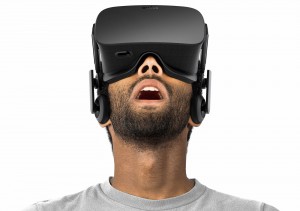 Initially, it will be compatible with Microsoft Windows PCs, with Max OS X and Linux support coming later.
Initially, it will be compatible with Microsoft Windows PCs, with Max OS X and Linux support coming later.
It boasts a 1080 x 1200 resolution display for each eye, a 90 Hz refresh rate, and a remarkably wide field of view. Integrated headphones allow it to output 3D surround audio to the wearer.
It translates both rotational and positional movement into the digital world. The rotational movement is picked up from the actual headset and the wearer’s head movements while the positional tracking is done by a USB-enabled IR sensor that sits on a desk or surface nearby. The positional tracking sensor can detect when the wearer is sitting, standing, or walking.
When you put on the headset, you are fully immersed in the environment that is being transmitted by your computer. Because the Oculus is strictly for PC, it will likely have the most support, especially from independent and third-party developers.
It is primarily meant for PC gaming, but can also be used for entertainment purposes. Some of the games that will be supported at launch include EVE: Valkyrie, Lucky’s Tale, HeroBound, Team Fortress 2, and many others.
Shipping delay aside, pre-orders for the Oculus Rift start at $599.
Due to an overload of pre-orders, shipping dates have been delayed until July 2016.
HTC Vive
The HTC Vive is a virtual reality headset being developed by HTC and Valve (Steam) through a collaborative effort. It is specifically meant to be used with the SteamVR platform, supported by Windows, Mac OS X, and Linux. Because the Vive has support from Valve – creators of the popular Steam gaming and software distribution platform – it is likely to see just as much support if not more than the Oculus Rift.
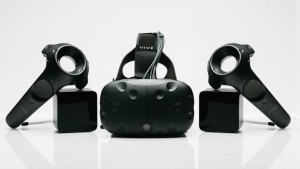 A majority of content in the Steam library is related to gaming, which means the Vive will be largely focused on gaming-oriented use. However, Steam does include some software applications and tools in their library, so it may eventually support some of those apps, as well. One such app called Tilt Brush by Google allows Vive wearers to paint in virtual reality.
A majority of content in the Steam library is related to gaming, which means the Vive will be largely focused on gaming-oriented use. However, Steam does include some software applications and tools in their library, so it may eventually support some of those apps, as well. One such app called Tilt Brush by Google allows Vive wearers to paint in virtual reality.
The Vive is meant to be used in an empty room, and it employs handheld motion tracking controllers to pick up the wearer’s position as they walk around. Through the unique controllers, players will be able to manipulate objects in the digital world, interact with different elements, and communicate with in-game characters and NPCs.
While it may seem dangerous to walk around a room with a headset on, the Vive sports a “Chaperone” safety system. A front-mounted camera is used to identify other moving or static objects in the room and the headset displays a live feed to the wearer so they can avoid collision or accidents.
In the bundle is the Vive headset, two handheld controllers, and two “Lighthouse” base stations to transmit data. The base stations allow the Vive to operate wirelessly, but there’s no word on what that actually means for battery life or usage. It can be used safely in a space of 15 x 15 feet.
Like the Oculus, the Vive includes two displays – one for each eye – running at a resolution of 1080×1200, with a refresh rate of 90 Hz.
As of February 2016, it has been confirmed that there a total of 107 games which will be supported at launch.
Pre-orders for the HTC Vive start at $799.
Playstation VR (Project Morpheus)
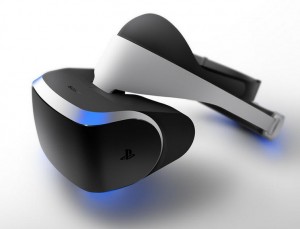 Sony’s Playstation branded VR headset was originally codenamed Project Morpheus. Now that it’s closer to launch, it’s been officially dubbed Playstation VR. It does not have a specific launch date set yet, but Sony has promised to release the platform sometime in 2016.
Sony’s Playstation branded VR headset was originally codenamed Project Morpheus. Now that it’s closer to launch, it’s been officially dubbed Playstation VR. It does not have a specific launch date set yet, but Sony has promised to release the platform sometime in 2016.
It is meant to be used with the Playstation 4 game console, and so it will be a gaming exclusive platform. The biggest difference between the PSVR and some of the other platforms on this list is that it is designed to render two different displays simultaneously. One display is meant to be viewed inside the headset, and the other is viewed on the TV connected to the PS4 system. This allows players to play with friends on the same console who aren’t wearing the headset.
An example Sony gave of the multi-display system working properly allowed players to experience multiplayer on separate displays in a game called Monster Escape. The player wearing the headset was a monster, and the other players using DualShock controllers (PS4 console controllers) were hunting the monster.
Final specs for the PSVR have not been released yet, but a prototype showed off at GDC 2015 included an OLED display operating at a resolution of 1920×1080 (providing a 960×1080 resolution for each eye), capable of displaying content at 120fps.
There’s no way to pre-order the headset yet, and no price has been offered by Sony.
Google Cardboard
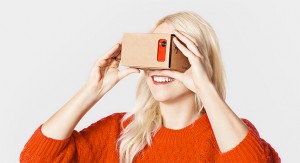 If we had to pick one VR platform for strange factor alone, Google Cardboard would win. It is extremely innovative and budget-friendly, so we’ll give them that.
If we had to pick one VR platform for strange factor alone, Google Cardboard would win. It is extremely innovative and budget-friendly, so we’ll give them that.
Cardboard is – as you’d expect – a VR headset made out of cardboard. You can build one yourself if you have the components, Google has made the design specs available for all. If you’d rather just buy one, you can pick a headset up from Google Play.
Google Cardboard is meant to be used in tandem with compatible Android smartphones and tablets. You slide the device into place which acts as the display, and the headset and integrated lenses turn the content into a truly virtual experience. It works with a variety of existing Android apps and games.
The actual Google Cardboard headset is about $15. There are a ton of other models which borrow the same design, some of which are made of better materials like plastic. The price for those starts at about $20 and up.
All in all, it’s an extremely affordable way to experience VR, so long as you already own a compatible Android device.
Zeiss VR One
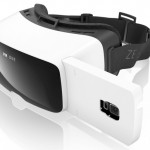 The Zeiss VR One uses the Google Cardboard ecosystem for compatibility, which means it works with any Android apps and games that the aforementioned platform supports.
The Zeiss VR One uses the Google Cardboard ecosystem for compatibility, which means it works with any Android apps and games that the aforementioned platform supports.
The Zeiss does not include a head strap. Instead, you are meant to hold the device to your face while viewing, and take it away when you’re done. The reason for this design is because the company wanted a device that could be easily passed between users for a social sharing experience.
The Zeiss VR One is also significantly cheaper than the Rift and Vive, at $120. Although, you’ll have to spend an extra $9 if you want a custom sized holding tray to match your device (Samsung Galaxy S5 and S6, iPhone 6 and 6S).
Samsung Gear VR
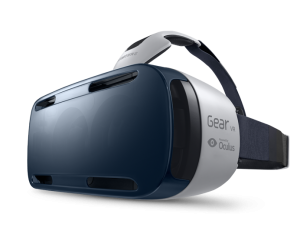 Like Google Cardboard and the Zeiss VR One, Samsung Gear VR is meant to be used with select smartphones to provide a portable VR experience. The Gear VR was designed by Oculus VR, the same company behind the RIFT.
Like Google Cardboard and the Zeiss VR One, Samsung Gear VR is meant to be used with select smartphones to provide a portable VR experience. The Gear VR was designed by Oculus VR, the same company behind the RIFT.
What sets the Gear VR apart is that it was developed specifically for use with Samsung Galaxy smartphones. It supports the Galaxy Note 5, S6 Edge+, S6, and S6 Edge. Sadly, no other models are supported so the Gear VR is only viable if you already own one of the supported Samsung devices, or if you plan on getting one soon.
The Gear VR features a Super AMOLED display, wide field of view, and head-tracking. It can be used to play games, but it also works with a variety of entertainment apps like Netflix. Rather than providing a more immersive VR experience, the Gear VR is focused on providing a large-scale HD quality display that you can view with the headset.
As they claim, “There are no bad seats at this theater.”
“The big screen is all yours. Whenever you’re ready, pick what you want from a vast selection of content and settle down with a snack of your choice.”
FOVE VR
The FOVE VR was also funded on Kickstarter, like the Oculus. What purportedly allows it to remain unique is that it supports eye-tracking – and is the first to do so – as opposed to head-tracking. Although, it does support head-tracking too as an additional feature.
![]() Because it supports eye-tracking, you can do things like aim with your eyes, make eye contact with NPCs and in-game characters, move in the digital world more naturally, and focus your vision on certain objects and elements of the digital world. Clearly, the FOVE team is going for realism.
Because it supports eye-tracking, you can do things like aim with your eyes, make eye contact with NPCs and in-game characters, move in the digital world more naturally, and focus your vision on certain objects and elements of the digital world. Clearly, the FOVE team is going for realism.
It features one of the highest quality displays yet, at a resolution of 2560×1440, a 100+ degree field of view, and a 60 fps refresh rate (up to 90).
It works with PC, Linux, and Mac OS X, and thanks to the SDK kit there should be plenty of content available. Developers can create FOVE VR experiences with Unity, Unreal Engine, and CryEngine, among others.
The FOVE team explains that the device can be used for purposes such as gaming, healthcare and medical, entertainment, education, social communication, and software development.
Pre-orders aren’t available yet, and there’s no word on a release date. However, you can submit your email address to receive updates and special deals from the company. They should send you a notice as soon as the FOVE VR is ready to purchase.
Avegant Glyph
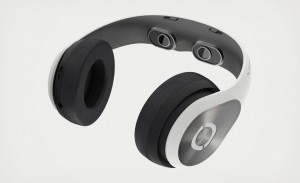 The Glyph does things a little differently than the other headsets on this list. Instead of focusing directly on gaming or virtual reality experiences, it’s meant to be used for entertainment purposes. More specifically, it provides a lightweight and portable virtual display, that’s like carrying a big-screen HDTV in your bag.
The Glyph does things a little differently than the other headsets on this list. Instead of focusing directly on gaming or virtual reality experiences, it’s meant to be used for entertainment purposes. More specifically, it provides a lightweight and portable virtual display, that’s like carrying a big-screen HDTV in your bag.
It’s capable of delivering full 360-degree video with head-tracking support. It plugs into devices via a single HDMI port, which means it’s compatible with virtually everything; including game consoles, streaming media players, smartphones, tablets, laptops, desktops, TVs, drone transmitters, and much more.
You don’t need specially authored content. You can simply plug into any device with an HDMI output and the content is displayed on the Glyph. Of course, it also includes integrated audio support, to output high-quality surround audio when you’re using it.
The Glyph is $699 and takes about 8-10 weeks to ship.
Razer OSVR
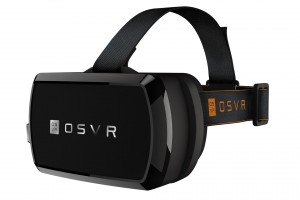 Razer’s OSVR stands for Open-Source Virtual Reality. This is because it relies on an open-source ecosystem which encourages developers to create content for the platform. With the OSVR Hacker Dev Kit, any developer can create games, entertainment, and experiences.
Razer’s OSVR stands for Open-Source Virtual Reality. This is because it relies on an open-source ecosystem which encourages developers to create content for the platform. With the OSVR Hacker Dev Kit, any developer can create games, entertainment, and experiences.
The hardware design is open-source which means that if you have the tools and skill you can build your own headset. If you don’t, you can pick up the OSVR Dev Kit for $299.99 which includes a pre-built headset.
Inside is a single 5.5″ OLED display capable of running at 60fps. The stock version offers 360-degree head-tracking, individual focus support for both eyes, a removable face mask, and a variety of sensors.
Unlike the Oculus Rift, HTC Vive, and Playstation VR, the OSVR will not provide a proprietary experience. It’s almost impossible to gauge what kind of support you’ll see from the device, at least until software development for the platform is a little farther along.
Still, this is another great headset you can use to get your VR kick on PC, and for gaming.
Freefly VR Headset
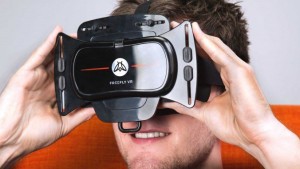 The way in which the Freefly VR Headset works is nearly identical to Google Cardboard, Samsung Gear VR and the Zeiss VR One. You plug a mobile device into the dedicated tray, and it acts as the actual display and content projector. The lenses inside the Freefly turn that content into a virtual, 360-degree experience.
The way in which the Freefly VR Headset works is nearly identical to Google Cardboard, Samsung Gear VR and the Zeiss VR One. You plug a mobile device into the dedicated tray, and it acts as the actual display and content projector. The lenses inside the Freefly turn that content into a virtual, 360-degree experience.
The Freefly is compatible with iOS and Android devices, and it works with the Google Cardboard ecosystem. So again, any apps supported by Google Cardboard will work with the Freefly VR Headset too.
The company offers worldwide shipping and has suitable purchase prices for a variety of currencies including USD, CAD, EUR, and GBP. The retail price for the Freefly VR Headset is $110, but it’s currently on sale for $79. Talk about affordable.
Just make sure your mobile is compatible with the Freefly Headset before you buy it!
ImmersiON-Vrelia GO
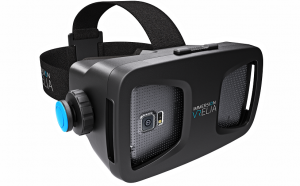 Again, the ImmersiON-Vrelia GO allows you to plug in your mobile device for a portable virtual reality system. If it seems like this is the trend right now, that’s because it is. Affordable VR – especially the kind that makes uses of a device you already own – is enticing to a lot of folks.
Again, the ImmersiON-Vrelia GO allows you to plug in your mobile device for a portable virtual reality system. If it seems like this is the trend right now, that’s because it is. Affordable VR – especially the kind that makes uses of a device you already own – is enticing to a lot of folks.
GO has been specifically designed with mobile gaming in mind and comes bundled with a wireless Bluetooth gamepad. It works with a handful of Android and iOS smartphones up to 6″ in size.
The GO will set you back $139.99 and takes 5-7 weeks to ship. That’s not a bad price at all, especially considering it comes with a Bluetooth gamepad.
Virtual Reality Headsets Will Soon Be Everywhere
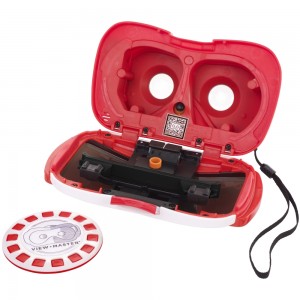 Imagine going into a movie theater and strapping virtual reality headsets on to watch a fully immersive movie. Or, consider visiting a virtual reality theme park that is filled with games, entertainment, and activities which take place in a digital world.
Imagine going into a movie theater and strapping virtual reality headsets on to watch a fully immersive movie. Or, consider visiting a virtual reality theme park that is filled with games, entertainment, and activities which take place in a digital world.
Both of these scenarios are possible, in fact, virtual reality theme parks already exist.
The point we’re trying to make is that you should expect to see virtual reality headsets all over the place soon. There are a lot of applications for this technology that haven’t been worked out yet, such as training and education, real life simulations, children’s toys and more.
What makes you excited for virtual reality? Are you looking forward to its entertainment value, or for its more practical purposes?
Will Fragmentation Be a Problem?
Because there are so many virtual reality headsets, one particular problem comes to mind. Since they all support different ecosystems and compatibility, does it mean we will see a fragmented market similar to what’s happened with the Android ecosystem?
Will we see some of these devices fail because of a lack of developer support or software options? It’s entirely possible, but it seems like things are going to pan out for now. Google Cardboard powers most of the mobile-related virtual reality headsets that are available, and the app support is similar across the board as far as that’s concerned.
As for the Oculus Rift, HTC Vive, and Playstation VR, they all have some pretty hefty support from a variety of developers and brands.
We’ll just have to wait and see how the rest of the virtual reality headsets do.

